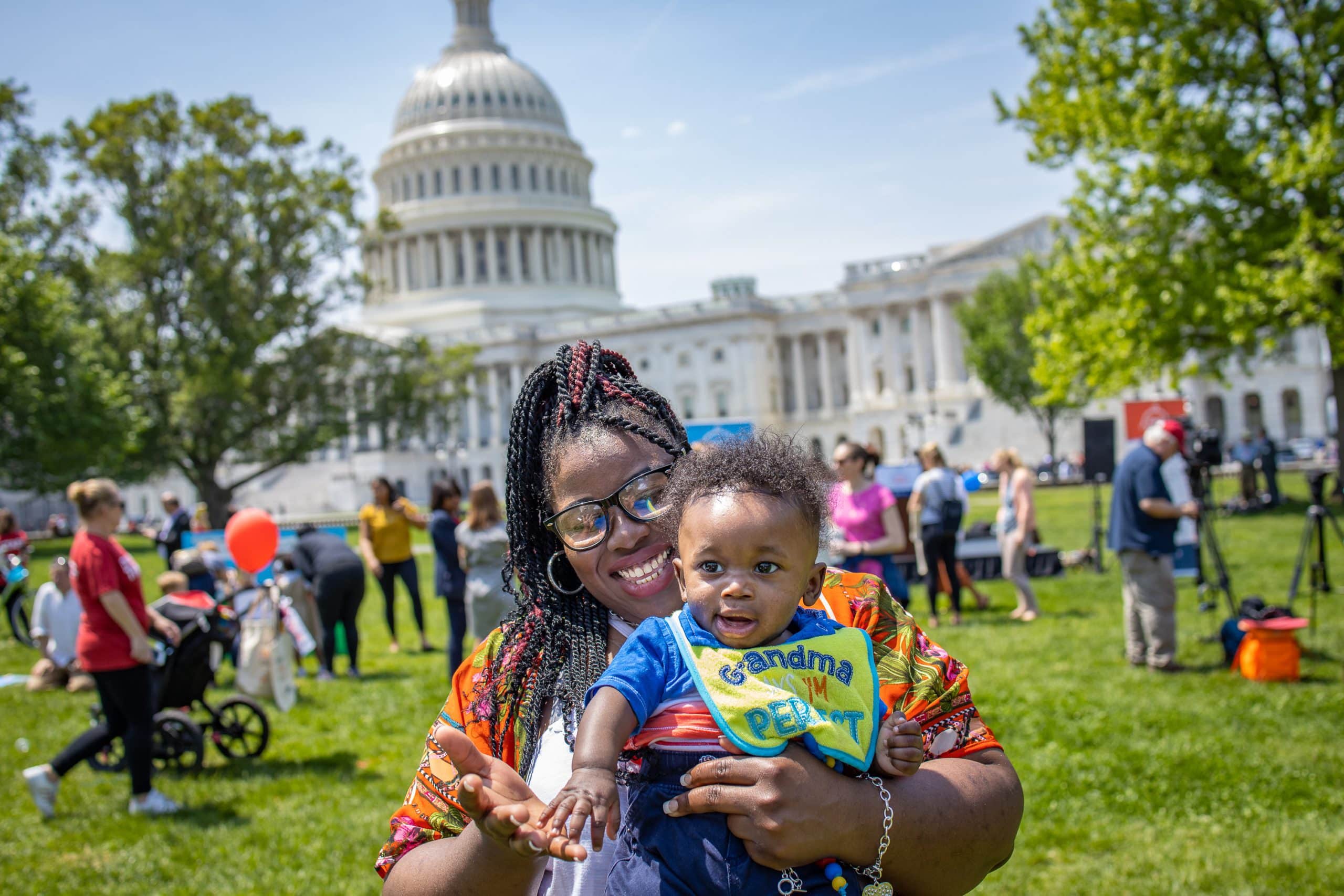24–36 Months: Social-Emotional Development

Social-emotional development is vital for infants, toddlers, and preschoolers as it helps them build healthy relationships, manage emotions, and develop social skills. Early support in areas like empathy, emotional regulation, and cooperation fosters resilience, mental well-being, and future academic success, setting the stage for positive lifelong outcomes. Explore the tips below to support social-emotional development:
As two-year-olds, children really begin to play interactively with their peers. Learn more about toddler social-emotional development.
Loving relationships give young children a sense of comfort, safety, confidence, and encouragement. They teach toddlers how to form friendships, communicate emotions, and to deal with challenges. Strong, positive relationships also help children develop trust, empathy, compassion, and a sense of right and wrong.
As two-year-olds, children really begin to play interactively with their peers. You will also see a real explosion in pretend play, a critical aspect of children’s development. Pretend play builds language, thinking, and social skills when children take on roles and develop their own ideas and stories.
Two-year-olds are also capable of empathy—understanding the feelings of others. You might see a child comfort a peer who is hurt or even cry when he sees another child who is upset. At the same time, toddlers still love to say “No!” and struggle with resolving conflicts with friends. Children develop more advanced social play skills, such as sharing and turn-taking, over time as they near age 3 and beyond. Here is what you might see happening among peers now as they play out a pretend story:
Josie, a 2 ½ year old, carefully laid the blocks out in a circle. “Anybody want some pizza?” she called out. Tomas, who was almost 3, said he wanted a big piece. “Does this have pepperoni? I don’t like pepperoni.” Josie said it was plain pizza and carefully scooped a block up with a toy spatula and put it on a plate. She tapped a few keys on the toy cash register and said, “That will be $20.” Tomas touched her hand, pretending to give her money. “Thank you very much,” said Josie.
What You Can Do to Support Toddler Social-Emotional Development
Help your toddler understand their feelings.
Now that toddlers have a firmer grasp of themselves as individuals, they experience more complex feelings like embarrassment and shame. Help your child make sense of their feelings by using words to describe emotions: You are feeling sad and jealous that Carly got the cupcake with the butterfly on it. I know that’s hard, but now you can choose the blue cupcake or the green one. Teaching children the words for emotions is important because, over time, it gives children the ability to talk about their feelings instead of acting them out.
In your work:
- Explore the idea of feelings through play. Use puppets to create a story about your child’s typical frustrations or fears, like having to share toys with a playmate, adjusting to a new baby, or separating from you when a babysitter comes. Suggest that your child draw a sad picture when they are down, or make angry shapes from play-dough when they are mad. Read books about feelings and talk about the pictures: Which child looks mad? Which looks afraid?
- Be a careful observer. Watch to see what your child is “telling” you as they play. For example, if your toddler dresses up in mommy clothes and acts out saying good-bye to their Teddy, they may be struggling with feelings about separations. You can help them work through these big ideas and feelings by playing along and reminding them that, while Teddy misses his mama, he knows his mama always comes back.
- Help your child express his feelings in age-appropriate ways. Give your child acceptable ways to share strong feelings. For example, toddlers can rip paper, stomp their feet or throw a foam ball when they are very mad. Help your little one understand there are many healthy, non- hurtful ways of expressing feelings.
Encourage early friendships.
Children need practice to learn to share, take turns, resolve conflicts, and experience the joy of friendship. Playing together helps children develop all of these important skills and strengthen toddler social-emotional development. When you provide fun choices for activities, a safe, supportive environment for play, and provide the needed guidance to help children share and resolve conflicts, they will discover the pleasure of early friendships.
In your work:
- Offer some play activities that don’t require sharing. Art projects, making music (where each child has an instrument), sand or water play are all options that can keep conflicts to a minimum.
- Ask children to imagine how their behavior might affect others: I see that you told Greta that she can’t play ball with you. Look at her face now. How do you think she is feeling?
- Make a “friend book.” Take photos of each of your child’s friends. Glue each photo to the top of a page and then list that child’s favorite toy, book, food, game, stuffed animal, etc. Staple together or tie the pages by punching a hole in each page, threading with yarn, and knotting. Read the book to your child so she can delight in hearing about herself and all the children she knows.
- Help your toddler to see others’ points of view, which encourages empathy: Casey is feeling sad because his daddy just said good-bye. Let’s see if he wants to read a book with us.
Let your child take the lead in deciding what to play.
Look for ways to help them continue to explore their interests. For example, if your toddler is into trains, line up several kitchen chairs to make a pretend train, read books about trains, and plan a visit your local train station if possible.
In your work:
- Comment on or describe what your child is doing. You are using so many beautiful colors to make that drawing. Or You are pretending to be the doctor and you’re taking care of the sick doggie.
- Get involved in your child’s play by following her lead. If they are making a pretend picnic, you can help prepare and pack the “food” in a basket. This helps your child learn about the pleasure of interactive play. It also is a chance for you to build on your child’s activities to help her learn. For example, you might ask: What weather is good weather for a picnic? When you are involved in your child’s play, they feel loved, important, and competent.
Support older toddlers’ developing skills.
Toddlers learn best when you let them play, explore, and follow their interests. They develop new skills when you give them just enough help so that they can master a challenge without becoming overly frustrated. For example, if you see your 30-month-old trying to build a block tower which keeps falling, you may suggest he build on the hard floor instead of the carpet. You might also suggest that he build a strong base, and help guide his hand to set the blocks once the tower gets tall. Here are some steps to helping toddlers become good problem- solvers.
In your work:
- Empathize with your child’s frustration. You are working so hard to get your mittens on! It takes time to figure it out.
- Ask your child if she knows what may be causing the problem.
- Offer your observations–for example, has she forgotten to poke her thumb into the thumb space of the mitten?
- Ask if she has any ideas about how to get it on correctly.
- Ask if she wants suggestions — How about putting your thumb in first and then your hand?
- Provide the support she needs to be successful— for example, helping her position her fingers to get them in correctly.
- Praise the process, not just the result: You are really trying to figure this out and sticking with it. That’s great! This helps children learn persistence and lets them know that trying hard is just as important as succeeding.
Help your child learn to resolve conflict in healthy, appropriate ways.
At this age it is very typical for toddlers to still struggle with sharing, turn-taking, and following rules. This is because they have not yet mastered self-control. You help them learn these important new skills when you calmly take them thought the process of resolving a conflict. You will probably have to go through these steps many, many times before they are able to do it themselves.
In your work:
- Keep it simple. Explain what happened in as few words as possible. Talk in a calm, not-angry voice.
- Go over what happened to make sure your child understands: You pushed Justin because you wanted the broom back.
- Point out the consequences of the child’s behavior: After you pushed Justin, he started to cry. It hurt. He felt sad and mad.
- Brainstorm better choice(s) your child can make next time. Older 2- year-olds may be able to offer some ideas on their own. Others will need suggestions, like using their words or asking for help from an adult. Most toddlers will need help to carry out these strategies.
Use language to describe feelings and experiences.
While you often hear adults asking toddlers to “use your words”, toddlers often they lack the words they need to describe their feelings. By helping your child name her feelings and practice ways to manage their emotions, she learns over time how to do it herself.
In your work:
- Put your child’s feelings into words. When your brother took your paintbrush, you felt really angry. Share your own feelings as well: I am so frustrated that I can’t find my keys.
- Read books about feelings. Ask your local librarian for suggestions for children’s books that talk about feelings. Some ideas include: My Many- Colored Days by Dr. Seuss, Lots of Feelings by Shelly Rotner, and The Feelings Book by Todd Parr.
Explain your reasons for limits and requests.
As toddlers approach age three, most use and understand language well enough to handle simple explanations. Point out how rules benefit your child: “When you help me by putting your lunch plate on the counter, I finish cleaning up quicker and then we can read an extra story.” “When you share toys, it means that everybody gets a chance to play.”
In your work:
- Talk about rules and limits in language that your child can understand. You may not hit. Hitting hurts. When you are mad, you can jump up and down or stamp your feet or come to me for a hug.
- Show your child the benefits involved in cooperating. Natural consequences help children understand the cause and effect involved in a rule, request or limit. For example, the natural consequence of throwing a toy truck is having it put away for a little while. But natural consequences can be positive too! Remind your child, “If you cooperate with getting your jackets on, then we’ll have more time at the park.” Strategies like this help children learn the rules and to make good choices over time.
Look for ways to make your home culture part of your child’s everyday routines.
A child’s culture is an important part of who he is. The connection he has to his culture shapes his identity and self-esteem in healthy and positive ways.
In your work:
- Teach your child’s caregivers the words your family uses for important people mother, father, grandparents) and things (bottle, blanket, pacifier, etc.).
- Choose books and music that reflect your home culture. These are often available at your public library for no charge and will quickly become a beloved part of your child’s daily routines—bedtime, bath-time, or just driving in the car.

Read More

